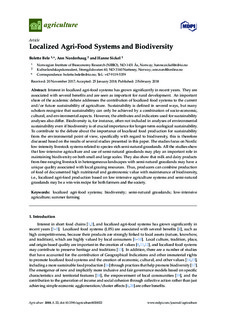| dc.contributor.author | Bele, Bolette | |
| dc.contributor.author | Norderhaug, Ann | |
| dc.contributor.author | Sickel, Hanne | |
| dc.date.accessioned | 2018-09-07T09:21:53Z | |
| dc.date.available | 2018-09-07T09:21:53Z | |
| dc.date.created | 2018-03-19T10:34:57Z | |
| dc.date.issued | 2018-02-02 | |
| dc.identifier.citation | Agriculture. 2018, 8 (2), . | nb_NO |
| dc.identifier.issn | 2077-0472 | |
| dc.identifier.uri | http://hdl.handle.net/11250/2561407 | |
| dc.description.abstract | Interest in localized agri-food systems has grown significantly in recent years. They are associated with several benefits and are seen as important for rural development. An important share of the academic debate addresses the contribution of localized food systems to the current and/or future sustainability of agriculture. Sustainability is defined in several ways, but many scholars recognize that sustainability can only be achieved by a combination of socio-economic, cultural, and environmental aspects. However, the attributes and indicators used for sustainability analyses also differ. Biodiversity is, for instance, often not included in analyses of environmental sustainability even if biodiversity is of crucial importance for longer-term ecological sustainability. To contribute to the debate about the importance of localized food production for sustainability from the environmental point of view, specifically with regard to biodiversity, this is therefore discussed based on the results of several studies presented in this paper. The studies focus on Nordic low-intensity livestock systems related to species-rich semi-natural grasslands. All the studies show that low-intensive agriculture and use of semi-natural grasslands may play an important role in maintaining biodiversity on both small and large scales. They also show that milk and dairy products from free-ranging livestock in heterogeneous landscapes with semi-natural grasslands may have a unique quality associated with local grazing resources. Thus, producers can combine production of food of documented high nutritional and gastronomic value with maintenance of biodiversity, i.e., localized agri-food production based on low-intensive agriculture systems and semi-natural grasslands may be a win-win recipe for both farmers and the society. | nb_NO |
| dc.language.iso | eng | nb_NO |
| dc.rights | Navngivelse 4.0 Internasjonal | * |
| dc.rights.uri | http://creativecommons.org/licenses/by/4.0/deed.no | * |
| dc.subject | Biologisk mangfold | nb_NO |
| dc.subject | Biodiversity | nb_NO |
| dc.title | Localized Agri-Food Systems and Biodiversity | nb_NO |
| dc.type | Journal article | nb_NO |
| dc.type | Peer reviewed | nb_NO |
| dc.description.version | publishedVersion | nb_NO |
| dc.rights.holder | © 2018 by the authors. | nb_NO |
| dc.subject.nsi | VDP::Landbruks- og Fiskerifag: 900 | nb_NO |
| dc.subject.nsi | VDP::Landbruks- og Fiskerifag: 900::Landbruksfag: 910::Planteforedling, hagebruk, plantevern, plantepatologi: 911 | nb_NO |
| dc.source.pagenumber | 17 | nb_NO |
| dc.source.volume | 8 | nb_NO |
| dc.source.journal | Agriculture | nb_NO |
| dc.source.issue | 2 | nb_NO |
| dc.identifier.doi | 10.3390/agriculture8020022 | |
| dc.identifier.cristin | 1573846 | |
| cristin.ispublished | true | |
| cristin.fulltext | original | |
| cristin.qualitycode | 1 | |

